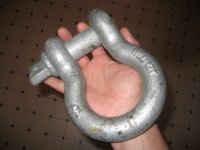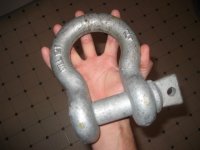Cord,
I work in a Mill and can honestly say that a 12 ton clevis is one of the smaller units we use everyday, so I know the size well and also what I'm talking about here.
I understand your dilemma, do we use rigging that is always the same rating as the the crane, NO we don't. What you must understand from an industry, and SAFETY (OSHA) standpoint you are NEVER permitted to go into the safety factor of any lifting device.....period. The only time this is permitted is when you have an Engineered Lift with a crane and you can load it to 125%of the rated capacity MAX, even for an engineered lift. In doing that there are all kinds of redundant safety precautions that must be adhered to when doing something like this, but anything below the hook MUST be rated for the load being lifted. I know I am relating all this to cranes, lifting, and such, but honestly from a tension, or working load standpoint there is no difference between lifting and pulling, as 5 ton of tension is 5 ton, no matter if it's lifted or pulled.
Now to your winch issue.....
Would I use a smaller shackle, yes I would. Most likely you will never exert that much tension on the thing because most winches only work with the first 25 feet of rope, and the winch is pulling at far less then its rated line pull. When you are out and about playing in the mud, there are always trees within 25 feet of your vehicle. As for your winch hook, you can always replace it with something bigger, or just loop the end then you can use any shackle you want. Remember, never saddle a dead horse if you loop the end, meaning when installing cable clamps to create the loop, NEVER pinch the tension side of the line pull cable, always pinch the looped part of the cable with the u-bolt.
I take a very personal approach to lifting because just like bolts and fasteners it is the most LEAST understood part of basic mechanics and honestly if not done right mistakes can kill you or your buddy.
Take care and have fun tuggin!
Oh.......just one other thing.....
Cranes usually have a safety factor of 3:1
Lifting items (shackles, slings, chains) usually have a safety factor of 5:1, sometimes 8:1 if rated for severe duty.
Craig


